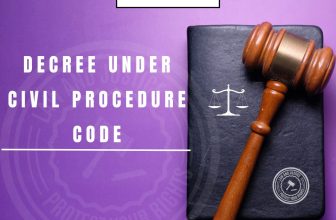
Rejection of a plaint refers to a legal action where the court dismisses a lawsuit at the very outset by refusing to entertain the plaintiff’s initial filing, known as a “plaint,” due to fundamental defects or non-compliance with legal requirements.
What is a Plaint?
A plaint is the written statement filed by the plaintiff to initiate a civil suit. It contains the essential facts of the case, relief sought, and the legal grounds for the claim. The plaint is the cornerstone of a civil suit, laying out the cause of action and enabling the court to understand the dispute.
Provision Related to Plaints
Order VII of CPC contains the provision related to plaints. It outlines the necessary details and requirements a plaintiff must include when filing a lawsuit, including specifics about the claim, the parties involved, and the relief sought, and also provides provisions for the court to reject a plaint if it lacks essential information or is legally deficient.
Essential Elements of a Plaint
The essential elements of a plaint include:
- Name of the court and case number.
- Name, description, and address of the plaintiff and defendant.
- Cause of action with material facts.
- Relief sought by the plaintiff.
- The estimated value of the subject matter of the dispute, necessary for determining court fees and jurisdiction.
- Verification by the plaintiff regarding the truth of the contents provided in the plaint.
For example, if a landlord files a suit for eviction, the plaint must include the tenant’s name, the property details, the grounds for eviction, and the relief sought (e.g., possession of the property).
Rejection of Plaint
A plaint can be rejected under Order VII Rule 11 of the Civil Procedure Code (CPC) if it doesn’t meet certain criteria. The purpose of this rule is to reduce frivolous litigation.
Grounds for Rejection of Plaint
Under Order VII, Rule 11, a court may reject a plaint if certain conditions are met. These grounds are as follows:
1. Failure to Disclose a Cause of Action (Order VII Rule 11(a))
A cause of action is the set of facts that entitles the plaintiff to seek legal relief. If the plaint does not disclose any cause of action, it can be rejected. If a plaintiff files a suit claiming damages without showing how the defendant’s actions caused harm, the plaint may be rejected.
2. Relief Claimed is Under-Valued (Order VII Rule 11(b))
If the plaintiff undervalues the relief and fails to correct it despite being directed by the court, the plaint can be rejected. If the plaintiff values a suit for property worth ₹1 crore at ₹10 lakh to avoid higher court fees, and does not correct this upon court instructions, the plaint may be rejected.
3. Failure to Pay Proper Court Fees (Order VII Rule 11(c))
If the plaintiff fails to pay the prescribed court fees and does not rectify this even after being directed by the court, the plaint can be rejected. For example, in a suit for recovery of money, if the plaintiff does not pay the required court fees, the plaint may be rejected.
4. Suit Barred by Law (Order VII Rule 11(d))
If the suit is barred by any law (e.g., limitation, res judicata, or statutory prohibition), the plaint can be rejected. For example, a suit to recover a time-barred debt (one filed after the limitation period) can be rejected under this ground.
5. Non-Compliance with Order VI Rule 15 (Verification of Pleadings)
If the plaint is not verified as per the procedure outlined in Order VI, Rule 15, it can be rejected.
6. Defective Presentation of Plaint
If the plaint is not properly presented (e.g., lack of essential details or incomplete form), it may lead to rejection.
Additional Grounds of Rejection of Plaint
- If the plaint is not stamped properly.
- If the plaint is not filed in duplicate.
- If the necessary parties weren’t included (non-joinder) in the suit or irrelevant parties (misjoinder) were included in the suit.
What Happens If a Plaint is Rejected?
The rejection of a plaint does not preclude the plaintiff from filing a fresh plaint, provided the defects are rectified. For example, if a plaint is rejected for undervaluation, the plaintiff can refile it with the correct valuation and court fees.
The rejection merely ensures that frivolous or meritless suits do not proceed, saving time and costs for the parties and the judiciary.
Difference Between Rejection and Return of Plaint
| Rejection of Plaint | Return of Plaint |
|---|---|
| Dismissal of the plaint on specific grounds. | The court does not have jurisdiction to try the case. |
| The plaint is not maintainable. | The plaint can be filed in the appropriate court. |
Conclusion
The rejection of a plaint under Order 7 Rule 11 is a procedural safeguard against frivolous, defective, or legally barred suits. By laying out clear grounds for rejection, the CPC ensures judicial efficiency and fairness. Plaintiffs should ensure that their plaint is properly drafted, adequately valued, and in compliance with legal provisions to avoid rejection.







3atf52
x6h9y0